skip to main |
skip to sidebar
"Sometimes less is more - less information, but highlighting it in a better way, sometimes better conveys important risk information.”
~Dr. Scott Gottlieb

Autumn love
Location: Kerimäki, Finland
Camera: Canon PowerShot A710 IS
Exposure: 0.005 sec (1/200)
Aperture: f/4
Focal Length: 5.8 mm
Don't get me wrong, I don't even like autumn, perhaps I never will. After all, why would I love it? It killed the bugs and flowers, and I am not exactly the forgiving type. Prior to the death of the greens though, they were bright autumn days and that was when I decided to give minimalism a try. Actually, I wasn't even sure whether I was going it the right way or not, but my previous visits to the photostream of one of my photography idols gave me ideas.
Leaves were the most available at the time because they were everywhere. I tried my very best to follow the rule of thirds. Additionally, I wanted dramatic contrast of colors that's why all of the shots had the blue sky in the background. It worked well, at least according to the reviews of my Flickr contacts. I used flash in some of the photos but it was on a low setting. Less detail means less amount of post-processing work to deal with, sometimes the image may not even require any modification at all. Ain't it easy?

Autumn colors
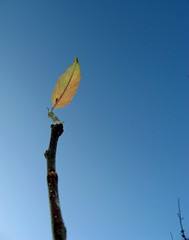
Alone but standing tall
The key is to make the subject interesting given the minimal information in the image. Applying simplicity as a technique will be very effective. If the subject is a flower, you wont need the distracting weeds in the background. Give the subject more room to breathe. The right choice of perspective can also make the shot stand out, no matter how tiny the subject may be. The viewers may only minimal detail, but creativity should always be at its maximum level because it will give the photo a spanking impact.
“Life is all about timing... the unreachable becomes reachable, the unavailable become available, the unattainable... attainable. Have the patience, wait it out It's all about timing.”
Stacey Charter

Camera: Canon PowerShot A710 IS
Exposure: 0.002 sec (1/640)
Aperture: f/4
Focal Length: 5.8 mm
I mentioned in one of my previous entries that beginners should try to take photos of calm insects like beetles. Lady bugs are usually easy to take photos of, but it's important to capture it while doing something cool like attacking aphids or when it spread its wings. Needless to say, you have to watch its every move and be quick enough to capture them. If you don't have the patience, don't bother giving insect photography a try. Concentrate on still life photography instead.
I have some photos of lady bugs that look interesting simply because I was quick enough to press the shutter. Thanks to the adrenaline rush that I experience whenever I see cute insects. It makes me so alert, my heart beats faster than usual, I am just very focused on the bug and I wouldn't care about what is going on around me. Sounds like a case of love-at-first-sight? I think so too :-) What I find surprising is the fact that I never get shaky, which is great thing because until now I am still to experience how to use a tripod. Someday I will use one, that is when I already have Parkinson's disease.
Alright, so timing is important to make captures interesting, but how likely is it that something special is about to happen while closely monitoring the movements of the ladybug? If the ladybug is not comfortable with its surroundings of course it will fly away. It usually happens when it has no where else to go or based on my experience, when it's on human skin, it won't stay there for long so be prepared to press the shutter before its flight. When disturbed, the lady bug will release a yellow smelly substance from its joints so it's best to avoid touching it, unless you want a dirty bug as a subject.
Some say that they would love to take photos of ladybugs but they don't know where to find them. Lady bugs are usually on leaves of aphid-infested plants like roses. I also saw one ladybug crawling on a raspberry. These beetles are tiny, about 4-10 mm long but you will spot those spotted beauties because of their colors which stand out against greens. Knowing how the ladybugs look like during their early stages of life will also help you find them later on when they are already the photogenic insects that many people love. Here's a photo of ladybugs in their ugly phase:

I wanted to kick my self because I didn't get to witness the transformation of this lady bug:
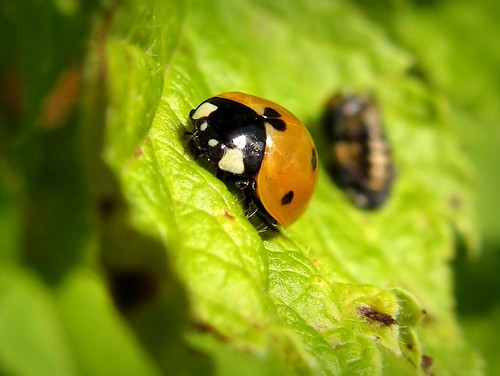
It would have been great to have photos of it as it come out of its larva shell.
A few days later, guess what happened? I arrived at the scene too late again! Just like those cops in some movies. But at least you can see the larva shell better in this photo:

Next summer I will watch them like a hawk. But for now let me show that there were instances when I was on time:
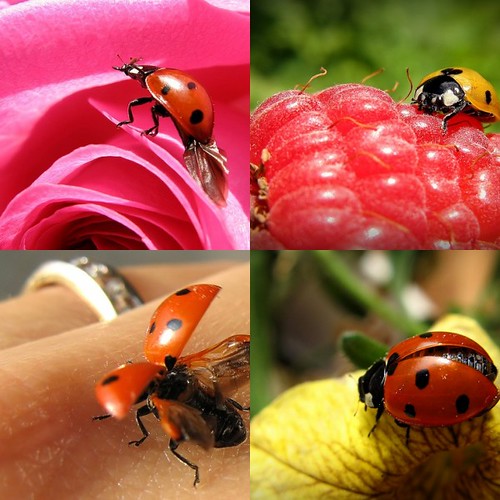
1. Ooops, dead-end!
2. Climb every berry
3. seconds before take-off
4. For Cara
Those shots are not perfect, but they are unique. I think they are good enough, considering the fact that those were produced by a 7.1 mp compact camera. Again these are proofs a small camera doesn't always produce images of poor quality. It's the lack of passion for the craft that makes photos look dull.
"Photography is still a very new medium and everything must be tried and dare... photography has no rules. It is not a sport. It is the result which counts, no matter how it is achieved"
~Bill Brandt
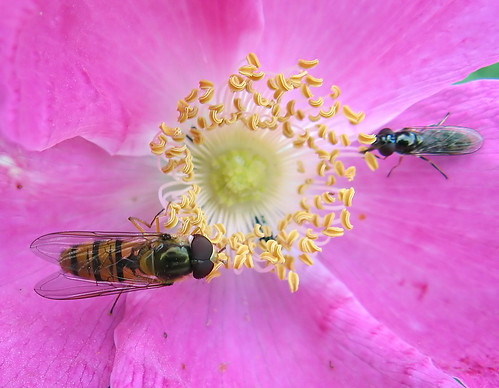
Pollen time
Camera: Canon PowerShot A710 IS
Exposure: 0.017 sec (1/60)
Aperture: f/3.2
Focal Length: 5.8 mm
Modifications: adjusted brightness & contrast levels, cropping, noise reduction
I started taking nature photos in the spring of 2007 using a Canon PowerShot A540. Back then, all I wanted was to have photos of ducks to upload to my Multiply page. Then I found out that the forum I frequent has a thread where members share their digital shots. I posted links to my photos and I am thankful because I got helpful tips from the regular posters of that thread. I realized that there is more to photography than pressing the shutter.
I am more famous in breaking rules than following them. So wasn't really happy when I read about the rules of photographic composition. I researched about the Rule of Thirds which sounded too complicated for me. Any sentence that mentions numbers will always be too difficult for me to understand. I was also a little hesitant to learn, because to me a hobby is supposed to be for fun, if there are rules then it would be a bit stressful. I got bored every time I read about basic stuff about photography until I realized that if I will not change my attitude towards learning new things, then I will never improve. My photos would probably be worse than photos taken by a 6-year-old. So I started to listen to criticism and I also followed my husband's advise and that was to think before pressing the shutter.
It took me a while before I understood what the rule of thirds is about. It's really very simple. The subject should not be in the center of the photograph. Divide the image by 2 vertical lines and 2 horizontal lines, the important elements of the image should be within the thirds. In the illustration below, the strong points must be in the red crosses.

Take the photo below as an example:
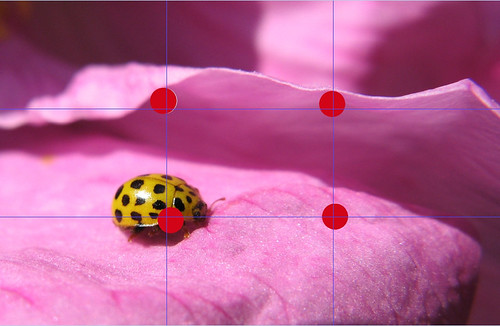
It's just the right spot for the beetle. Because if it was on the next dot, then there would have been useless empty space behind the beetle. It would also look like it was going out of the frame, thus directing the viewer's attention off the image and I don't want that to happen. The title of the photo is Journey, hence I wanted more space on the direction where the beetle was going. To view the image without lines click here.
I believe that I also observed the rule of thirds in this photo:

Bid me farewell
Exposure: 0.017 sec (1/60)
Aperture: f/3.2
Focal Length: 5.8 mm
I don't follow the rule of thirds all the time. In flower macros, for example, when the flower's center look very interesting, expect me to forget about the thirds. The shape and form of the subjects would sometimes dictate whether you should follow the rule of thirds or not. If you want to highlight symmetry, it would be fine if the subject is centered. Here are pieces of evidence showing that sometimes centering works:
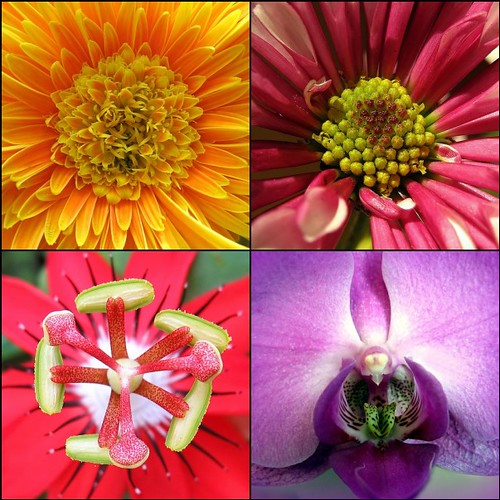
Dare to break some rules once in a while. Don't be afraid of criticisms, bear in mind that you can never please everyone. If you are a newbie, don't feel bad if someone occasionally tells you where you went wrong. Never make your low-pixel camera as the scapegoat for poorly-composed shots, after all, you were the one who made that camera work by pressing the shutter. The photo is either good or bad because of the person behind the camera. Why? Because we have brain cells and our cameras don't. To me the number one rule is to make use of your brain, of course you can break this rule.. at your own risk.
















